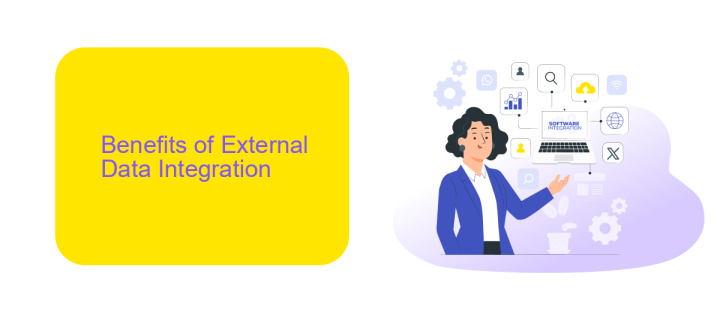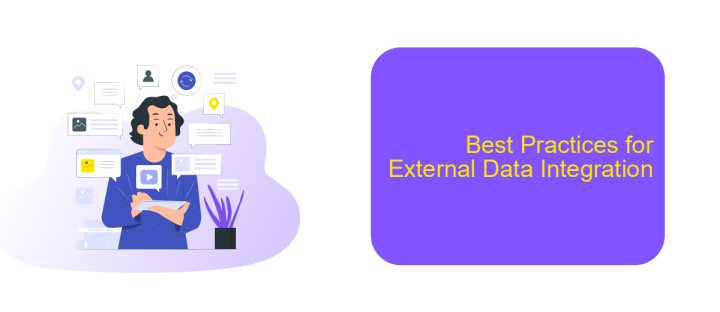External Data Integration
External data integration is a crucial process for modern businesses aiming to leverage diverse data sources for enhanced decision-making. By seamlessly incorporating data from external platforms, companies can gain deeper insights, improve operational efficiency, and stay competitive in a rapidly evolving market. This article explores the key benefits, challenges, and best practices for integrating external data into organizational workflows.
Introduction
External Data Integration is a critical aspect of modern business operations, enabling organizations to streamline processes and enhance decision-making by leveraging data from various external sources. This process involves the seamless incorporation of data from third-party systems, APIs, and other external databases into an organization's internal systems.
- Improved data accuracy and consistency
- Enhanced operational efficiency
- Better decision-making capabilities
- Increased agility and responsiveness
One effective way to manage external data integration is through specialized services like ApiX-Drive. This platform offers a user-friendly interface and robust features that simplify the integration of various external data sources. By using ApiX-Drive, businesses can automate data flows, reduce manual efforts, and ensure real-time data synchronization, ultimately driving greater efficiency and productivity.
Benefits of External Data Integration

External data integration offers numerous benefits for businesses looking to enhance their decision-making processes and operational efficiency. By aggregating data from multiple external sources, companies can gain a more comprehensive understanding of market trends, customer behavior, and competitive landscapes. This holistic view enables more informed strategic planning and helps identify new opportunities for growth. Moreover, integrating external data can improve data accuracy and reliability, as it allows for cross-referencing and validation against internal datasets.
In addition to these strategic advantages, external data integration can streamline operational workflows and reduce manual data entry errors. Tools like ApiX-Drive facilitate seamless data integration by automating the transfer of information between various platforms, ensuring that data is always up-to-date and readily available. This not only saves time but also allows employees to focus on more value-added tasks. Ultimately, leveraging external data integration can lead to better business outcomes, improved customer satisfaction, and a stronger competitive edge.
Challenges of External Data Integration

Integrating external data into existing systems presents several challenges that organizations must navigate to ensure seamless operations. These challenges can range from technical issues to organizational barriers, each requiring careful consideration and strategic planning.
- Data Quality and Consistency: Ensuring that the external data aligns with internal data standards is crucial. Discrepancies can lead to errors and unreliable insights.
- Security and Privacy: Safeguarding sensitive information during data transfer is essential. Compliance with data protection regulations adds another layer of complexity.
- Compatibility and Integration: Different data formats and systems require robust integration solutions. Tools like ApiX-Drive can facilitate the process by offering customizable and automated data integration services.
- Scalability: As data volumes grow, maintaining performance and efficiency becomes challenging. Scalable solutions are necessary to handle increasing data loads effectively.
Addressing these challenges requires a combination of technology, such as ApiX-Drive for seamless integration, and strategic planning to ensure data quality, security, and scalability. By proactively tackling these issues, organizations can leverage external data to enhance decision-making and drive business growth.
Best Practices for External Data Integration

Effective external data integration is crucial for leveraging diverse data sources to enhance business intelligence and operational efficiency. By following best practices, organizations can ensure seamless and secure data integration, minimizing the risk of errors and maximizing data utility.
One of the key practices is to clearly define the objectives and requirements for data integration. Understanding what data is needed, its sources, and how it will be used is essential for successful integration. Additionally, choosing the right tools and platforms, such as ApiX-Drive, can significantly streamline the integration process.
- Establish clear data governance policies to ensure data quality and compliance.
- Implement robust data security measures to protect sensitive information.
- Regularly monitor and maintain data integration processes to address any issues promptly.
- Utilize automated integration tools like ApiX-Drive for efficient and error-free data transfer.
By adhering to these best practices, organizations can achieve a more reliable and efficient external data integration process. This not only enhances data-driven decision-making but also ensures that data remains accurate, secure, and readily accessible.
Conclusion
In conclusion, effective external data integration is crucial for organizations seeking to enhance their decision-making processes and operational efficiency. By seamlessly connecting disparate data sources, businesses can gain comprehensive insights and drive more informed strategies. Leveraging advanced tools and platforms, such as ApiX-Drive, simplifies the integration process, ensuring that data is accurately and consistently synchronized across various systems.
Moreover, the ability to automate data workflows with solutions like ApiX-Drive reduces manual intervention, minimizes errors, and saves valuable time. As the landscape of data continues to evolve, organizations must prioritize robust integration strategies to stay competitive and responsive to market demands. Ultimately, successful external data integration empowers businesses to harness the full potential of their data, fostering innovation and growth.
FAQ
What is external data integration?
Why is external data integration important?
What are some common challenges in external data integration?
How can automation help in external data integration?
What should I consider when choosing an external data integration tool?
Apix-Drive is a universal tool that will quickly streamline any workflow, freeing you from routine and possible financial losses. Try ApiX-Drive in action and see how useful it is for you personally. In the meantime, when you are setting up connections between systems, think about where you are investing your free time, because now you will have much more of it.

